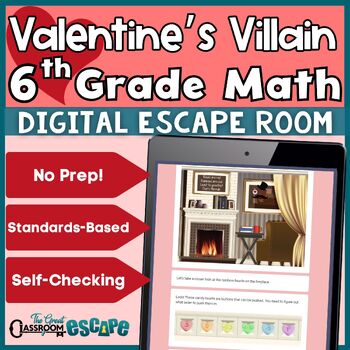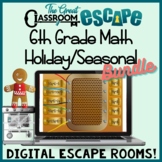6th Grade Valentine's Day Math Activity No Prep Digital Escape Room Game
- PDF
- Google Apps™
- Easel Activity

What educators are saying
Also included in
- It's hard to keep students engaged before holidays and vacations. These digital breakouts for sixth grade math skills keep kids focused reviewing important math standards. Best of all, they are easy for teachers to implement! All of these online escape rooms are automated by a Google Form™. There aPrice $23.56Original Price $29.45Save $5.89
Description
Can your 6th graders use their math skills to save Valentine's Day? In this digital escape room, knowledge of sixth grade math skills such as dividing fractions and mixed numbers, solving rate and ratio word problems, ordering rational numbers, solving expressions with exponents, and more will be put to the test. Keep your class engaged during your Valentine's Day class party, encourage cooperative learning, and review standards in an exciting way! This activity requires students to access a Google Form™ (no e-mail addresses required). The form will work on computers, tablets, or even phones! There are no clues to hide, and the escape room process is automated by the Google Form, making this activity super simple to implement!
A wide variety of sixth grade math standards are reviewed in this escape room. Please download the preview file to make sure that your class has covered all of the material. Skills that will be required to complete the puzzles:
- Order rational numbers from least to greatest. This includes numbers such as -(-2), -.5, 1, etc.
- Divide mixed numbers
- Divide decimals
- Solve expressions with exponents. Example (which is written with exponents as superscript rather than with a caret in the form): (3 x 2)^2 + 4^3
- Find the greatest common factor of two number less than 100
- Find the least common multiple of two numbers less than 12
- Find the percent of a number
- Solve rate and ratio word problems
- Convert between fraction, percent, and decimals
These skills are used in five creative puzzles, some with multiple parts. This activity is recommended to be completed in groups of 2-4, but can be done individually for review, enrichment, or just for fun!
Included in the PDF:
- "Valentine" with QR code leading to the Google Form to pass out to students explaining the mission
- URL to access the form for those who do not use QR codes
- Quickstart guide
- Detailed instructions
- Detailed answer key and teacher tips
- Success signs to snap a photo with when students complete the escape room
- Optional link for experienced Google Forms users to create a copy of the form to save to their own drive
FAQ
- Do students need to have Gmail™ accounts? NO! Anyone with internet access and a tablet, computer, or even phone can complete the breakout.
- How long will this take? That is the hardest question as the answer varies depending on each classroom, student, or group. Some students with a firm grasp on the concepts covered in this escape room will be able to complete the challenge quickly (20-30 minutes), but most will take longer. The majority of students will take between 35-55 minutes. The form will not save student data, so if you are worried about your students not finishing on time, simply have them write their answers on scratch paper. They can then come back and quickly re-enter their answers and pick up where they left off.
- Will students have to search the web to figure out the puzzles? NO! All of the information needed will be provided in the Google Form™. The math in this activity is all standards-based.
- Can this be used for distance learning? Absolutely! The last three pages of the pdf include detailed directions and tips to help you successfully implement this activity for remote learning.
See all of the Great Classroom Escape's Valentines Day Escape Rooms
Check out more Sixth Grade Math Escape Rooms
Visit The Great Classroom Escape to see all of our digital breakouts!







